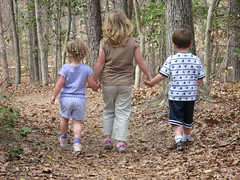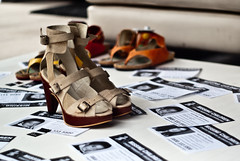It has been nearly a decade since Elizabeth smart was kidnapped from her own bed and taken into a horrid nightmare for nine long months. We hear of stories like hers and those of other victims, like Jaycee Duggard as well as children who are still missing or have been found dead and realize that in a world where we value education, we must discuss with our children the ugly truth as well as the the unfounded fears.Today's post comes courtesy of author, Melissa Harker Ridenour who has first hand experience with how a crime against a friend affected her.
There are No Monsters in the Closet
 Image by vastateparksstaff via Flickr
Image by vastateparksstaff via Flickr Part of loving our children is the responsibility for protecting them from any kind of harm and raising them to be happy, healthy adults, and, of course, reassuring them at bedtime that there are no monsters in the closet. But how do we make our children feel safe and secure and, indeed, keep them safe and secure from monsters out there in the real world? As parents, most of us learn as we go, do the best we can, and just hope for the best.
Parenthood can be so scary too. Having children is like having your heart forever walking around outside your body – facing whatever trials and tribulations that cross their paths along the way. As parents, we tend to want to shield and protect. But, as parents, we can’t always be with our children. That is why it’s necessary to empower children to learn to stay safe themselves as well. We, as parents, need to make it a priority to empower our children to take a pro-active role in staying safe from abduction and predator harm. Empowering children to stay safe from such risk has always been a priority for me – so much so that I published a book on the issue.
Sometimes people ask me why I wrote a children’s book on such a subject. I have a few reasons for writing such a book, beginning with a traumatic memory from my childhood. When my best friend and I were in the fifth grade, more years ago than I care to think about, I awoke on a Monday morning to my mother having to explain to me that I wouldn’t see my friend in school anymore. She explained to me, as gently as she could, that my friend had been abducted, raped, and murdered the evening before. That was a difficult thing for me to understand at that age. But the trauma stuck with me thereafter. As a child, when I would walk to school, I would have to pass the spot where my friend’s body was discovered. I remember for the longest time running, terrified, past that spot each time. Adding to the tragedy of the story is the fact that her mother, the next year, committed suicide. She was never able to cope with the loss of her daughter, especially in such a violent way.
That haunting memory has always affected me, especially when I became a mother myself. One of my greatest fears as a young mother, and even now that my children are grown with children of their own, is that something similar could happen to my children or grandchildren. That fear, as well as children’s naivety and sense of invincibility, combined with the alarming statistics regarding missing and exploited children, are motivations that prompted me to write a book that would teach children strategies for staying safe and would help parents learn how to keep children safe from abduction or predator harm.
 Image by R. Edelmann via Flickr
Image by R. Edelmann via FlickrAccording to the most recent statistics, 79% percent of abductions are committed by strangers and 21% by acquaintances. The concept of “stranger” is difficult for children to understand. Children are sometimes accustomed to hearing their parents use the phrase, “stranger danger”. That phrase should actually be retired. Such a phrase can tend to make children feel as though all strangers are bad when, in fact, most people, including most strangers are good. But some people, including some strangers aren’t so good. It’s impossible for anyone, especially children, to know with absolute certainty who is good and who is bad. Teaching children stranger safety, and whom they should and should not trust, without making them distrustful of people in general, is a delicate balancing act, but it can be done.
I can best typify the safety needs of children with the words of Princess Diana, "I don't want expensive gifts; I don't want to be bought. I have everything I want. I just want someone to be there for me, to make me feel safe and secure."
Access information about What Would You Do? A Kid’s Guide to Staying Safe in a World of Strangers at Melissa Harker Ridenour Books AuthorMelissaHarkerRidenour.com

No comments:
Post a Comment